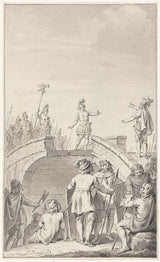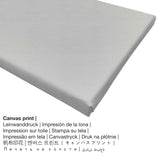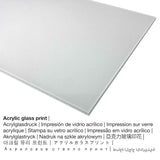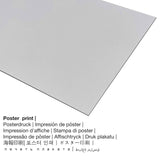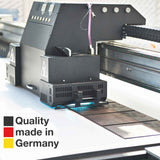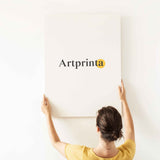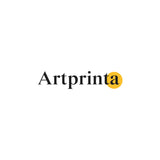Jacobus Buys, 1779 - Mkparịta ụka udo n'etiti Claudius Civilis na - mbipụta nka mara mma
Ụtụ gụnyere. Mbupu gbakọrọ na ndenye ọpụpụ.
Nhọrọ ihe onwunwe
Anyị na-enye ihe dị iche iche dị iche iche na nha maka ngwaahịa ọ bụla. Anyị na-ahapụ gị ka ịhọrọ nha na akụrụngwa ọkacha mmasị gị n'etiti nhọrọ nhazi ngwaahịa ndị a:
- Mbipụta akwụkwọ mmado (akwa akwa akwa): Our poster print is a printed cotton canvas paper with a slightly roughened surface finish, that resembles the original version of the masterpiece. It is particularly designed for putting your art print using a customized frame. Please bear in mind, that depending on the size of the poster print we add a white margin of approximately 2-6cm around the work of art, which facilitates the framing with your custom frame.
- Mbipụta kwaaji: A printed canvas, not to be confused with a canvas painting, is an image printed directly on cotton canvas material. Additionally, a canvas print produces a attractive and appealing ambience. Your printed canvas of this artpiece will let you turn your fine art print into a large work of art. Canvas prints are relatively low in weight, which means that it is easy and straightforward to hang up your Canvas print without the help of any wall-mounts. Canvas prints are suited for any kind of wall.
- Mbipụta enyo acrylic: The print on acrylic glass, often labelled as a plexiglass print, changes the original work of art into home decoration. Further, it makes a distinct alternative to aluminium and canvas prints. The work of art will be custom-made thanks to the help of state-of-the-art UV print technology. It creates vivid and sharp color shades. The great benefit of an acrylic glass art print is that contrasts and smaller details will be more recognizeable due to the subtle tonal gradation in the print.
- Aluminom ihe eji eme ihe: An Aluminium Dibond print is a print with an impressive depth effect - for a modern look and a non-reflective surface structure. The bright & white components of the artwork shimmer with a silk gloss, however without the glow.
Disclaimer: We try the best we can in order to depict our products with as many details as possible and to illustrate them visually. Please keep in mind that the tone of the printed materials, as well as the printing can diverge to a certain extent from the presentation on your monitor. Depending on your settings of your screen and the quality of the surface, color pigments might not be printed as exactly as the digital version depicted here. Considering that the are processed and printed by hand, there may as well be slight variations in the exact position and the size of the motif.
Kedu ihe ndị otu curator nke Rijksmuseum state about this work of art made by Jacobus Buys? (© - site na Rijksmuseum - www.rijksmuseum.nl)
Peace Negotiations between Claudius Civilis and Petilius Cerealis the broken bridge, 70 n. Chr. Design for print.
Nchịkọta nke ngwaahịa nka kpochapụwo
a 18th narị afọ nka nka aha ya Peace Negotiations between Claudius Civilis and mere site na nwoke artist Jacobus zụrụ. Taa, ọrụ nka a bụ nke Rijksmuseum's nchịkọta dijitalụ, nke bụ ihe ngosi nka kacha ukwuu maka nka na akụkọ Dutch site na Middle Ages ruo ugbu a. Site n'ikike nke Rijksmuseum (licensed - public domain).Creditline of the artwork: . What is more, the alignment is portrait and has a side ratio of 9: 16, nke pụtara na ogologo bụ 45% mkpụmkpụ karịa obosara. Jacobus Buys was a painter of Dutch nationality, whose art style was primarily Rococo. The artist lived for 77 afọ - born in 1724 in Amsterdam, North Holland, Netherlands and deceased in 1801 in Amsterdam, North Holland, Netherlands.
Ozi ahaziri na nka
| Aha ọrụ nka: | "Mkparịta ụka udo n'etiti Claudius Civilis na" |
| Nhazi nka nka: | sere |
| Okwu mkpokọta: | nka ochie |
| Nhazi oge: | 18th narị afọ |
| Afọ nka: | 1779 |
| Ogologo afọ nka nka: | 240 afọ |
| Egosiputara na: | Rijksmuseum |
| Ebe ngosi nka: | Amsterdam, Netherlands |
| Weebụsaịtị nke ihe ngosi nka: | Rijksmuseum |
| Ụdị nka nka: | ngalaba ọha |
| Site n'aka: | Rijksmuseum |
Banyere ngwaahịa a
| Nkewa bipụta: | nka nka |
| Usoro mmeputakwa: | dijitalụ mmeputakwa |
| Usoro nhazi: | mbipụta dijitalụ (Mbipụta UV ozugbo) |
| Production: | Germany |
| Ụdị ngwaahịa: | mmepụta ihe na-achọ |
| Eji ngwaahịa a chọrọ: | Ụlọ ihe ngosi nka, ụlọ mmepụta ihe nka |
| Nhazi nka nka: | nhazi ihe osise |
| Ụdị anya: | 9: 16 ogologo: obosara |
| Akụkụ onyonyo pụtara: | ogologo bụ 45% mkpụmkpụ karịa obosara |
| Materials: | ígwè obibi akwụkwọ (aluminium dibond), ebipụta canvas, mbipụta akwụkwọ mmado (akwụkwọ kwaaji), mbipụta iko acrylic (nwere ezigbo mkpuchi iko) |
| Kanvas n'elu etiti ihe ndọtị (mbipụta akwa akwa): | 50x90cm - 20x35" |
| Acrylic glass print (nwere ezigbo mkpuchi iko) nhọrọ: | 50x90cm - 20x35" |
| Nhọrọ nha nke akwụkwọ mmado (akwụkwọ kwaaji): | 50x90cm - 20x35" |
| Nhọrọ aluminom dibond (ihe aluminom) nhọrọ: | 50x90cm - 20x35" |
| ụba: | enweghị etiti |
Ozi izugbe gbasara onye na-ese ihe
| aha: | Jacobus zụrụ |
| Aliases: | J. Buys, B[uys], J. Buis, Buijs Jacobus, Jacob Buys, Buys Jacobus, Buys, Buys Jacob, Jacobus Buys |
| Gender: | nwoke |
| Obodo onye nka: | Dutch |
| Ọrụ nke onye na-ese ihe: | onye na-ese ihe |
| Mba onye si: | mba netherland |
| Nkewa onye nka: | nna ukwu ochie |
| styles: | Rococo |
| Oge ndu: | 77 afọ |
| Afọ ọmụmụ: | 1724 |
| Obodo amụrụ: | Amsterdam, North Holland, Netherlands |
| Nwụrụ n'afọ: | 1801 |
| Nwuru na (ebe): | Amsterdam, North Holland, Netherlands |
© echebe nwebiisinka | Artprinta.com

